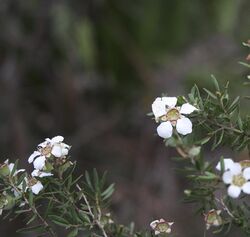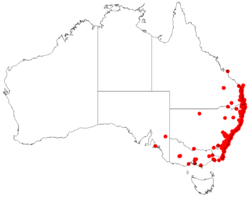Biology:Leptospermum juniperinum
| Prickly tea-tree | |
|---|---|

| |
| At Somersby | |
| Scientific classification Error creating thumbnail: Unable to save thumbnail to destination
| |
| Kingdom: | Plantae |
| Clade: | Tracheophytes |
| Clade: | Angiosperms |
| Clade: | Eudicots |
| Clade: | Rosids |
| Order: | Myrtales |
| Family: | Myrtaceae |
| Genus: | Leptospermum |
| Species: | L. juniperinum
|
| Binomial name | |
| Leptospermum juniperinum | |

| |
| Occurrence data from AVH | |
Leptospermum juniperinum, commonly known as the prickly tea tree,[2] is a species of broom-like shrub that is endemic to eastern Australia. It has narrow, sharply pointed leaves, white flowers usually arranged singly on short side shoots and small fruit that remain on the plant when mature.
Description
Leptospermum juniperinum is a broom-like shrub that typically grows to a height of 2–3 m (6 ft 7 in–9 ft 10 in) and has thin, rough bark. The leaves are narrow elliptical or narrow lance-shaped, 5–15 mm (0.20–0.59 in) long and 1–2 mm (0.039–0.079 in) wide with a sharply pointed tip. The flowers are usually borne singly on short side shoots and are 6–10 mm (0.24–0.39 in) wide on a pedicel less than 1 mm (0.039 in) long. The floral cup is 1.5–2 mm (0.059–0.079 in) long, the sepals broadly egg-shaped and about 1.6 mm (0.063 in) long, the petals often about 3.5 mm (0.14 in) long and the stamens 1–1.5 mm (0.039–0.059 in) long. Flowering mostly occurs from November to December and the fruit is a capsule usually less than 7 mm (0.28 in) wide and that is not shed when mature.[2][3]
Taxonomy
Leptospermum juniperinum was first formally described in 1797 by James Edward Smith in Transactions of the Linnean Society of London.[4][5] The specific epithet is a reference to a perceived similarity to Junipers.[6]
Distribution and habitat
Prickly tea-tree grows in near-coastal swamps, heath and sedgeland and on sandstone cliffs between Fraser Island in Queensland and Ulladulla in New South Wales.[2][3]
References
- ↑ "Leptospermum juniperinum". https://biodiversity.org.au/nsl/services/apc-format/display/98648. Retrieved 12 April 2020.
- ↑ 2.0 2.1 2.2 "Leptospermum juniperinum". Royal Botanic Garden Sydney. http://plantnet.rbgsyd.nsw.gov.au/cgi-bin/NSWfl.pl?page=nswfl&lvl=sp&name=Leptospermum~juniperinum. Retrieved 12 April 2020.
- ↑ 3.0 3.1 Thompson, Joy (1989). "A revision of the genus Leptospermum (Myrtaceae)". Telopea 3 (3): 418–420. doi:10.7751/telopea19894902.
- ↑ "Leptospermum juniperinum". APNI. https://id.biodiversity.org.au/instance/apni/524756. Retrieved 12 April 2020.
- ↑ Smith, James Edward (1797). "Botanical Characters of Some Plants of the Natural Order of Myrti". Transactions of the Linnean Society of London 3: 263–264. https://www.biodiversitylibrary.org/item/13713#page/290/mode/1up. Retrieved 12 April 2020.
- ↑ Francis Aubie Sharr (2019). Western Australian Plant Names and their Meanings. Kardinya, Western Australia: Four Gables Press. p. 229. ISBN 9780958034180.
Wikidata ☰ Q647815 entry
 |

